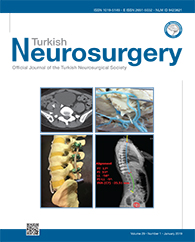2Central South University, Xiangya Hospital, Postdoctoral Research Workstation of Pathology and Pathophysiology, Basic Medical Sciences,
3Central South University, School of Information Science and Engineering, Changsha, Hunan Province, China
4Central South University, Xiangya Hospital, Department of Pathology, Changsha, Hunan Province, China
5Central South University, Xiangya Hospital, Key Laboratory of Cancer Proteomics of Chinese Ministry of Health, Changsha, Hunan Province, China DOI : 10.5137/1019-5149.JTN.21931-17.2 AIM: To summarize the imaging features of spinal peripheral primitive neuroectodermal tumor (spPNET) patients.
MATERIAL and METHODS: The computed tomography and magnetic resonance imaging features of 10 spPNET patients, four men and six women, were retrospectively analyzed, and their clinicopathological data were reviewed.
RESULTS: The mean age of the patients was 24.7 years (range, 3-44 years). Ten spPNET lesions were found in the ten patients, including six extradural and four intradural extramedullary lesions. Radiologically, spPNET typically presented as heterogeneous isointense lesions with a heterogeneously enhanced pattern. A "vault wall-like growth" pattern, a linear enhancement pattern, and vertebral bone involvement tended to be found in the extradural lesions, whereas a ring enhancement pattern was found in the extramedullary intradural lesions. Positive Ki-67 expression might be related to necrosis, bone destruction, and hemorrhage.
CONCLUSION: A well-defined spinal mass showing isointensity/attenuation with heterogeneous enhancement accompanied by other imaging features may be suggestive of spPNET and should be added to the list of differential diagnosis.
Keywords : Computed tomography, Diagnosis, Magnetic resonance imaging, Primitive neuroectodermal tumor, Spinal peripheral




